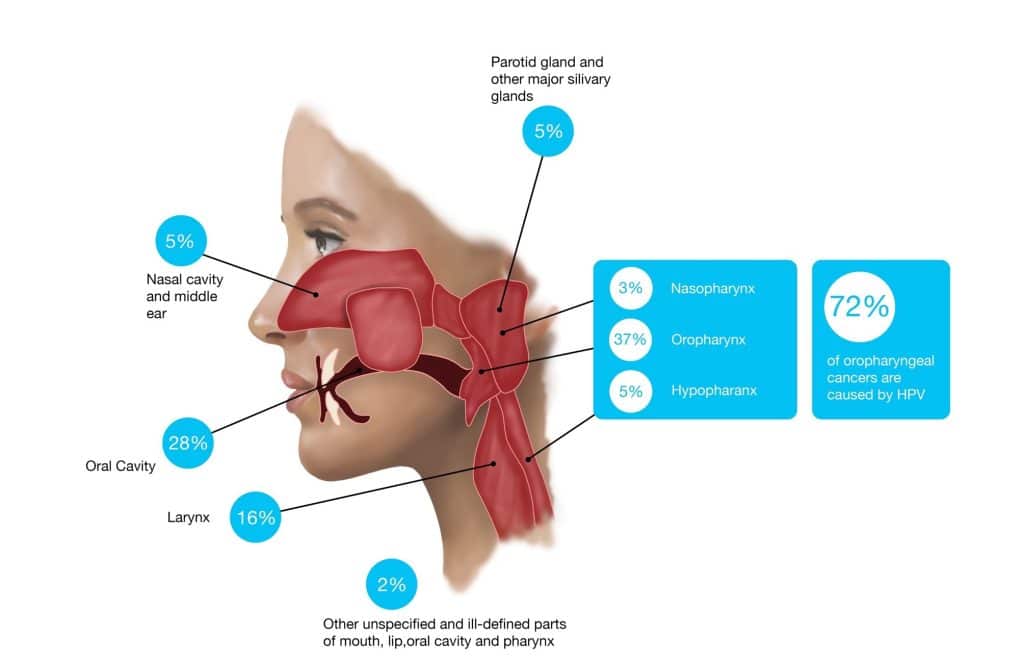Human papillomavirus (HPV)
What is HPV?
Human papillomavirus (HPV) is an extremely common group of more than 200 related viruses. In fact, most people will have had at least one HPV infection at some point in their lives without even knowing it. While many types of HPV cause no symptoms or issues, they are broadly categorised into low-risk and high-risk types.
- Low-risk HPV: These types may cause warts or verrucas on the skin, such as on your hands or feet, but are generally harmless.
- High-risk HPV: This type can lead to serious health problems in a small number of people, including cancers like cervical cancer and head and neck cancers (particularly affecting the tonsils, base of the tongue, and throat).
Oracle Head & Neck Cancer UK are raising awareness of the human papillomavirus (HPV) and its impact on rising cancer rates.
High-risk HPV infection is a major cause of several cancers, including those in the head and neck, cervix, and anogenital areas. It is responsible for almost all cervical cancers (99.7%), as well as a significant number of anal, penile, vulval, and vaginal cancers.
Each year in the UK:
- 3,200 new cervical cancer cases are reported, with almost all caused by high-risk HPV.
- 1,484 cases of anal cancer are diagnosed, 91% linked to HPV.
- Around 700 penile cancer cases, with 63% linked to HPV.
- Over 1,000 new vulval and vaginal cancers, more than 70% linked to HPV.
HPV is also the fastest-growing risk factor for head and neck cancers, with over 3,300 new cases annually in the UK, mainly affecting the oropharynx (tonsils, base of the tongue, and throat). Rates of oropharyngeal cancer in men now exceed cervical cancer in women, and these cancers are increasing by 30% per decade.
HPV-related cancers have doubled in the past 20 years and are among the fastest-growing cancer types in the UK.
Most HPV infections go unnoticed and are cleared by the body’s immune system within two years. However, high-risk HPV can stay dormant in your body for years, even decades, potentially causing issues later in life.


Low-risk HPV Conditions
For the majority of people, low-risk HPV won’t cause any symptoms or health problems. However, in some cases, it can lead to the development of warts or verrucas on the skin.
High-risk HPV Conditions
Most people who have an HPV infection do not realise it as they have no symptoms. The infection is usually cleared by the immune system within two years.
HPV can remain in your body for many years without it causing problems. However, high-risk types may cause problems later-on in life, including cervical and several types of head and neck cancer.
Conditions linked to low-risk HPV
Most of the time low-risk HPV does not cause any symptoms or problems. However, in some people, low-risk types of HPV can cause warts and verrucas on the skin.
Conditions linked to high-risk HPV
While most high-risk HPV infections do not cause any problems, a small number of people may develop cancers as a result of long-term, persistent infection. These cancers include:
- Head and Neck Cancer, particularly in the tonsils, tongue, and throat
- Cervical Cancer
Symptoms of HPV-related cancers can vary depending on the area affected. If you experience any persistent symptoms, especially in the head or neck area, for more than 3 weeks, it’s important to consult your GP promptly.
How is the human papillomavirus (HPV) spread?
HPV can be spread through:
- any skin-to-skin contact of the genital area
- any type of sexual contact
Prevention Through Vaccination
At Oracle Head and Neck Cancer UK, we are committed to raising awareness about the dangers of high-risk HPV and the cancers it can cause. That’s why we’ve launched the Sign Away Cancer campaign, aimed at increasing HPV vaccine uptake in schools.
Vaccination is a powerful tool in preventing HPV-related cancers. By supporting our campaign, you’re helping to protect future generations—because prevention is always better than cure.



